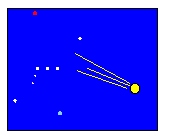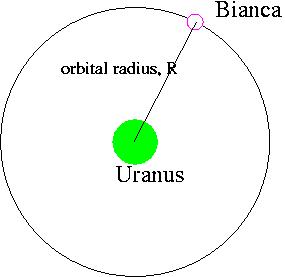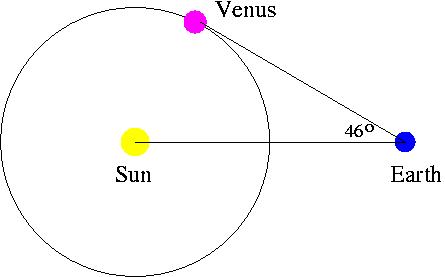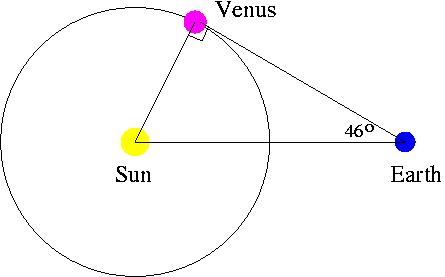 |
Astronomy 101 Problem Set #7 Solutions |  |
 |
Astronomy 101 Problem Set #7 Solutions |  |
Problem #1: Bianca is a moon of Uranus. Bianca has a circular orbit whose radius is 5.92 x 104 km, and its orbital period is 0.435 days.
a) Calculate Bianca's speed in its orbit around Uranus.
b) From this information, calculate the mass of Uranus.
Solution: Speed is defined as distance per time, e.g., "miles per hour," "meters per second," etc. In this problem (as in the Exam!) we have both a distance and a time, so calculating the speed does not require some fancy formula.
Let's start with a simple diagram of the situation:

Here, the moon Bianca orbits in a circle around Uranus. How far does it travel to complete one lap around Uranus? Not the radius of its circular path, but the circumference, which is
This is the acceleration that Bianca must experience in order to travel in a circle, and that acceleration must be caused by the gravity of Uranus (there really isn't any other choice). Newton told us that the acceleration due to gravity is:
Problem #2: Mercury's iron core occupies 40% of the volume of the planet, but accounts for 60% of its total mass. Using the mass and radius of Mercury in the back of your textbook, calculate the average density of the other part of Mercury, that is, the rocky outer layers.
Solution: Density is mass per volume, so here we just need to figure out the mass and volume of the outer part of Mercury. Since we're given the mass and volume of Mercury's inner iron core, we really only need to subtract these values from the total mass and volume of Mercury to get the value we need.
Looking in the back of our textbook, I find that radius of Mercury is 2439 km, or,
Problem #3: The maximum elongation of Venus (that's the largest angular separation between Venus and the Sun, viewed from Earth) is 46 degrees.
a) Draw a diagram indicating the position of the Sun and Earth, the orbit of Venus, and its location when it appears at its maximum elongation.
b) From this diagram (and the knowledge that the Earth-Sun distance is 1 A.U.), calculate the radius of Venus' circular orbit.
Solution: The largest angle between the direction to the Sun and the direction to Venus will occur for the following geometry,

where the line from the Earth to Venus just touches the circle that defines Venus's orbit (mathematicians would say that this line is "tangent" to the circle). We can then make a triangle with vertices at the Earth, Venus, and the Sun,

where the angle at Venus is a right angle (i.e., 90 degrees). Why this one and not the one at the Sun? Look at the picture. If the angle at the Sun were a right angle, Venus would be at the "top" of its orbit in the picture. But clearly, the elongation is larger when Venus's just a little bit closer to the Earth than when it's at the top. So the angle at the Sun must be slightly smaller than 90 degrees.
The angle at Venus is 90 degrees because the tangent line is always perpendicular to the radius, as drawn at left below:

If the line weren't perpendicular to the radius line, it would "dig in" to the circle and wouldn't be tangent (see other two figures above).
So, from the geometry of the Sun-Venus-Earth triangle, and knowing SOHCATOA, we get that
Sin(elongation) = Sun-Venus distance/Sun-Earth distance = Sun-Venus distance/ 1 A.U.
so,
Sun-Merc distance = 1 A.U. x Sin(46 degrees) = 0.72 A.U.
